Brown bathroom tiles: features and design options
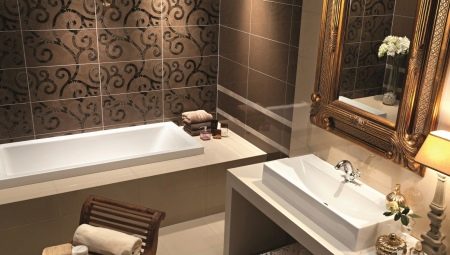
The brown color scheme is one of the most popular bathroom solutions. Such popularity of the brown color is due to its influence on the psychological health of a person. Brown has a positive effect on the nervous system, relaxing and giving a sense of security. Moreover, this color always looks expensive and noble. Learn more about how to create a beautiful brown bathroom in this article.
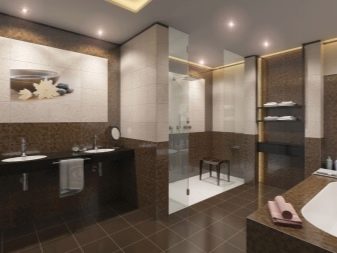
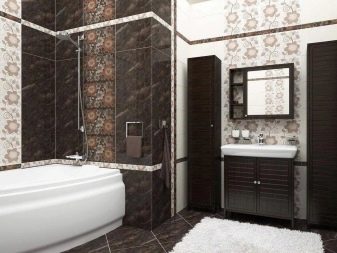
Views
The modern market offers a wide variety of bathroom tiles. It can be of various sizes, shapes and materials of manufacture. Large tiles are used to decorate all types of surfaces. Such tiles can be either monochromatic or decorated with a pattern or pattern.
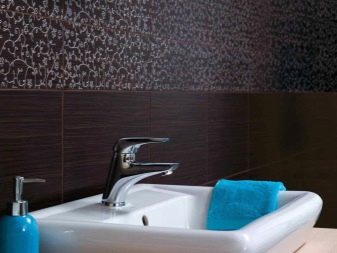
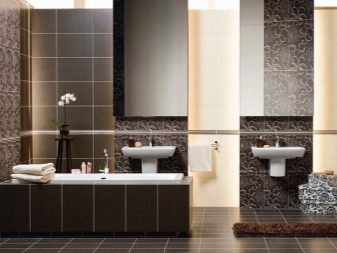
But small tiles are used mainly for wall decoration, since they are rather thin and therefore do not have sufficient strength. With its help, they create an interesting mosaic that looks appropriate in any stylistic solution.
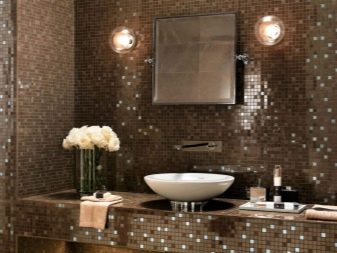

Tiles of non-standard shapes look more interesting. Unique patterns and designs are created from such models. So, in stores there are models of round, rectangular, diamond-shaped and other shapes. As for the materials of manufacture, ceramic, porcelain stoneware and clinker tiles are mainly used for the bathroom.


Ceramic tiles are considered a classic option. It most often has the shape of a rectangle, as well as a special coating that protects it from water and moisture. Ceramics are used to decorate floors, ceilings and walls. The shape is mostly square and rectangular.
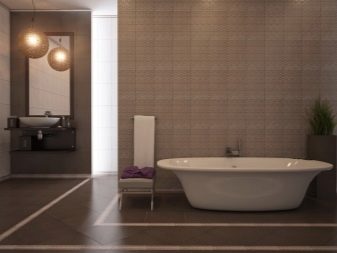
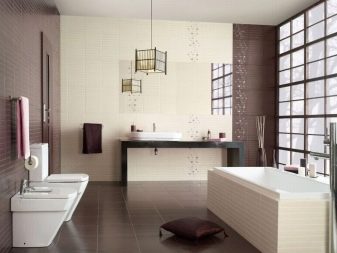
Porcelain stoneware is an excellent substitute for ceramic products. Especially often, floors are trimmed with this material, since the tiles have a high density and are difficult to break. Tiles of both standard shapes and unusual options are made from porcelain stoneware.
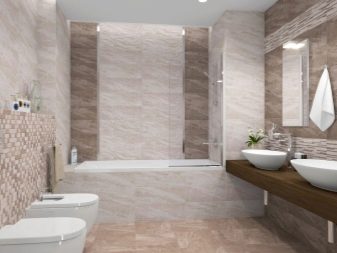
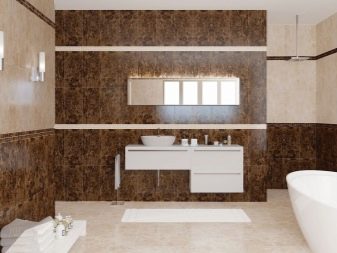
Clinker models are less often used in the interior of the bathroom. Such tiles are characterized by durability and strength. The clinker looks original and warm. Often such tiles are used to create an interior in the style of minimalism, modern, high-tech, country, loft and ethnic style.


Shades of brown
The brown palette has a wide range of tones and shades, so it is quite difficult to determine the optimal tone. When choosing a color, consider the size of the room, the color and the amount of furniture.
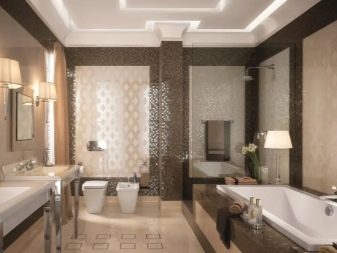
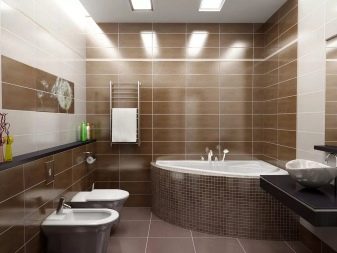
Light shades
Light and delicate shades will help create a cozy room in which you can always relax and forget about your problems. Light colors are non-annoying and never boring. The most popular lighter shades of brown are as follows.
- Coffee with milk. This is the optimal solution for the bathroom, as the color goes well with other shades of brown and other color schemes. It is used both to create a color accent and to decorate the background. Moreover, this shade is well suited for creating patterns and ornaments.
- Milk chocolate. The shade is suitable for sweet lovers. It is often used in interiors in classic, Victorian and Provence style. However, this color has a significant drawback - it increases appetite, which makes it undesirable for those who carefully monitor their weight.
- Caramel. It is a warm and cozy color. It is successfully combined with pastel shades and is suitable for creating designs in Provence, country or eco style.
- Beige. It is the most common color and goes well with various shades of brown and other colors.
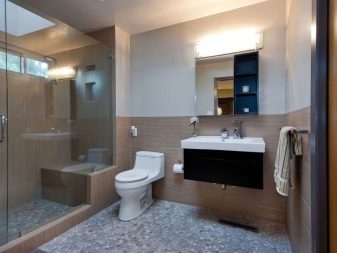

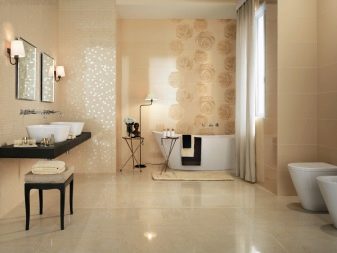

Dark tones
Dark brown is not less common than light shades. However, dark tones visually reduce the room, so they are often combined with lighter colors. Dark tiles with patterns look original. But it is important not to overdo it with such decorative elements, since the dark color looks deep and rich, therefore it does not require many decorative elements.
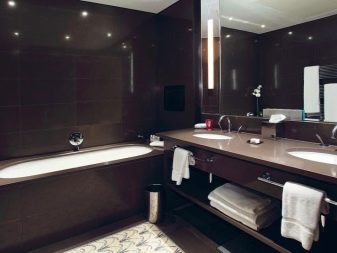
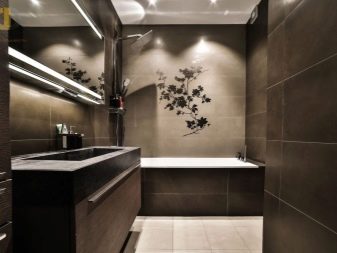
Design
There are several main types of brown tile designs:
- plain;
- under a stone;
- under the tree;
- options with prints or drawings.
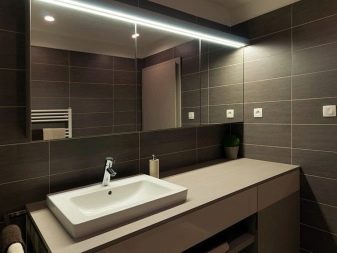
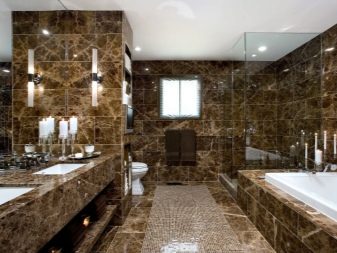
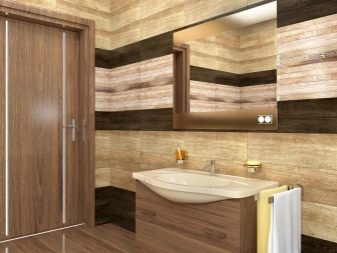
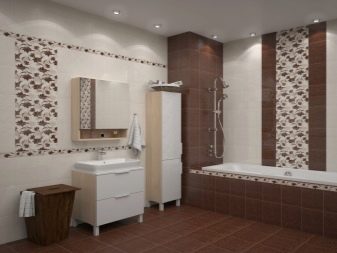
Plain tiles look too calm and monotonous, so they are often diluted with tiles with patterns or prints. You can also use different shades of brown or other colors to create unusual mosaics.
The tiles can be decorated with all kinds of patterns or designs. Floral and other plant themes are often used. For example, when creating an interior in green-brown tones, a print with palm trees looks appropriate. However, brightly patterned or painted tiles cannot be used to decorate all surfaces in the room, as this will overload it. It is used exclusively for creating small accents.
A fashionable novelty is 3D tiles. With its help, they create amazing and realistic drawings.



Woodgrain models, on the other hand, are rarely combined with other types of tiles, since such a design looks noble and interesting due to its texture. You can use tiles of different colors - this will make the interior more contrasting. Moreover, woodgrain options have the same visual effects as natural wood, so they make the room more cozy and warm... And such a tile is perfect for interior decoration in various styles, for example, loft or country.

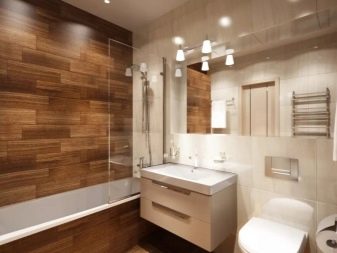
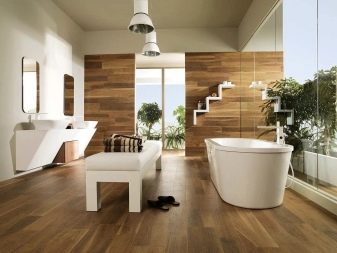
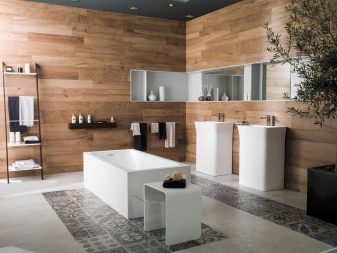
Models with imitation stone attract attention and create a non-standard and bright interior. Such options have a stylish appearance.However, a bathroom finished with a stone look will always look cold, so it is better to choose warm lighting and complement the interior with cozy and delicate elements.



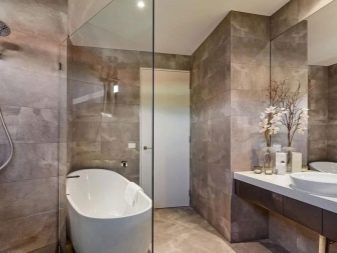
Color combinations
Various combinations of shades of brown are ideal to create a warm and cozy bathroom. Brown also goes well with shades of beige: it can be creamy, powdery, peach, coffee and other tones. Lighter shades will brighten the room, visually expanding it.
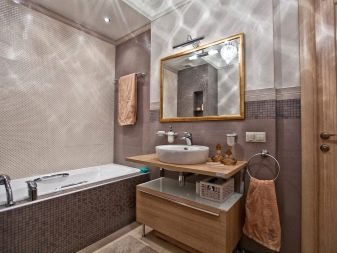
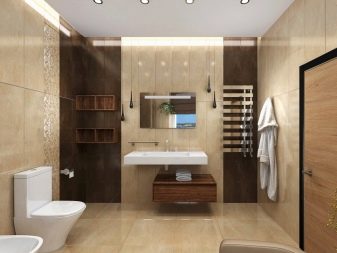
Combining brown and white is another great idea. This combination is most common in bathrooms with brown tiles, as bathroom furniture is often white in color. It is important to consider that white is a cold tone, therefore such a tandem creates a rather cold and restrained interior.
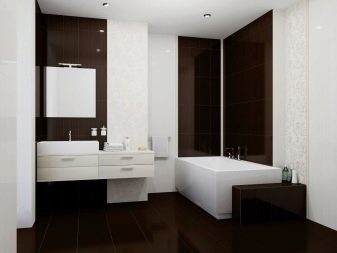
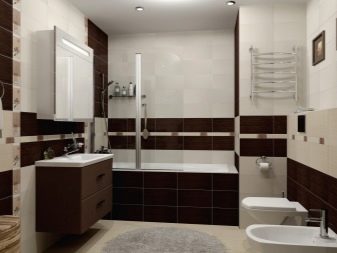
Gold goes well with any shade of brown. Such a duet always looks elegant, rich and deep.
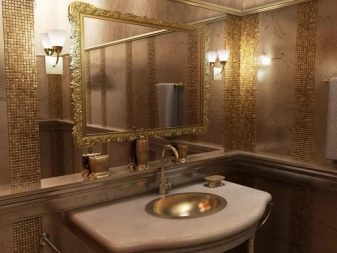
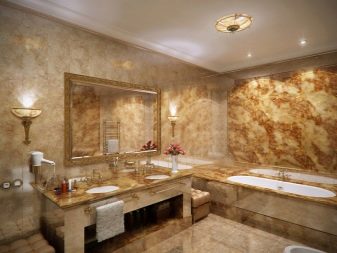
As for bright and unusual colors, they are rarely combined with brown. More often, other colors are added to the interior using textiles or various decorative items. However, if you want to create a custom design, then you can resort to the following design options:
- a combination of pastel colors with brown tiles;
- using a thin line of white tile to separate brown and another bright shade.
The best bright "neighbors" of brown are shades of blue, green, yellow, red and orange.

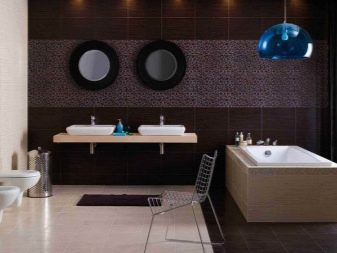
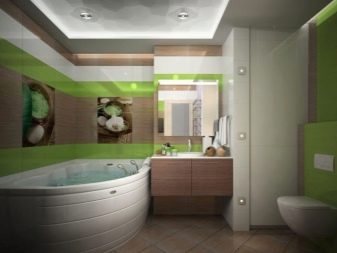

Styles
Brown tiles are versatile as they suit different bathroom styles. Let's consider the most popular solutions.
- Country, provence and eco-style. These are traditional folk styles that always look warm and cozy. These styles are characterized by the use of wicker baskets, fresh flowers and handmade textiles.
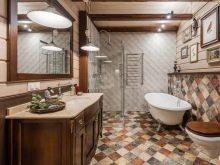
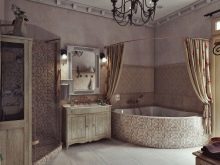
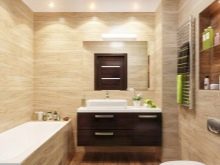
- Modern and loft. These are modern and rather laconic designs. The color palette is usually cold, so darker shades of brown are often used. Tiles with floral patterns will not work for these styles, but solid colors or options with geometric patterns will fit perfectly.
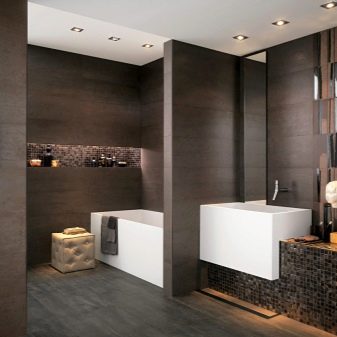
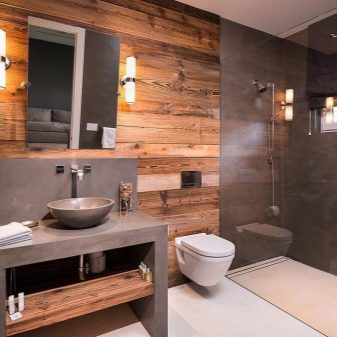
- Classic style. The interior is often decorated with gold or bronze patterns and wood. Both dark and light shades of brown can be used. As a rule, large-sized tiles are used for cladding. As for the decor, you can use various figurines, furniture with curly legs, or even paintings.


- Arabic, Chinese and Japanese. These exotic styles are a solution for the brave lovers of the East. Exotic design always looks original and warm enough. The brown palette will fit perfectly into such an interior. Bamboo tiles work especially well. You can also find tiles with traditional oriental motives.
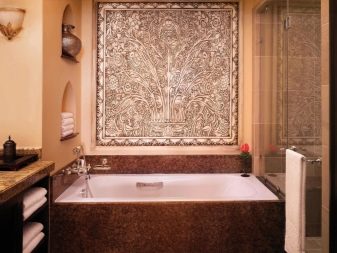
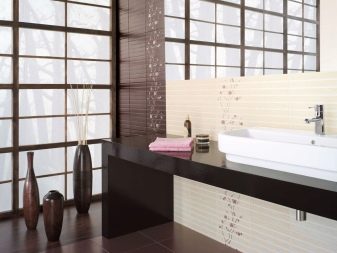
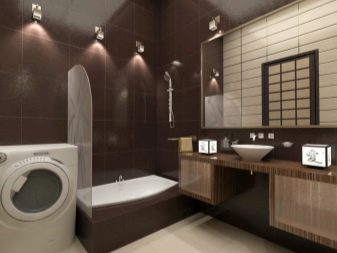
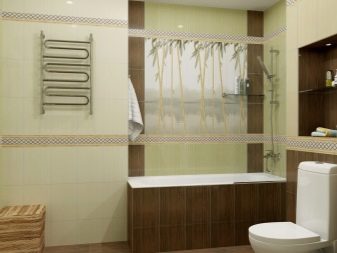
Beautiful ideas
- The classic bathroom in beige and brown colors looks warm and cozy. Wall patterns and additional decorative elements make the design more interesting.

- A spacious bathroom, designed in brown shades, will be an excellent option for connoisseurs of comfort.
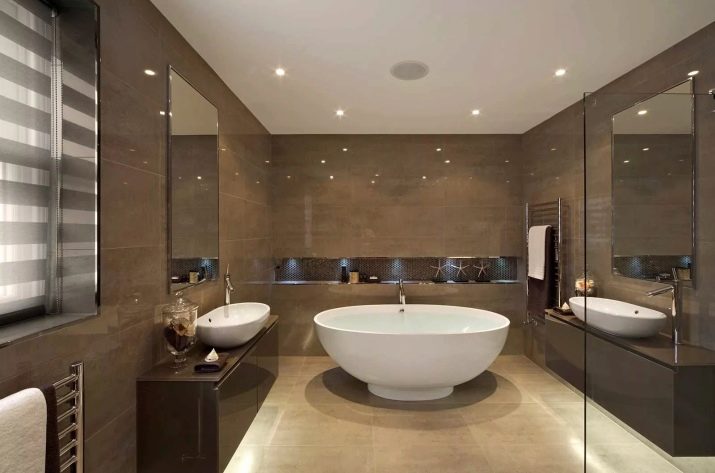
- The room looks original, decorated with fine mosaics with gold splashes.
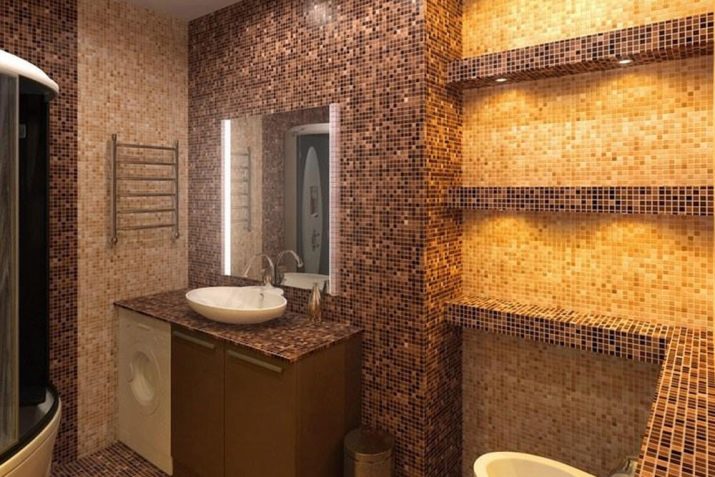
- Brown goes well with green. Such a tandem will make the interior design unique.
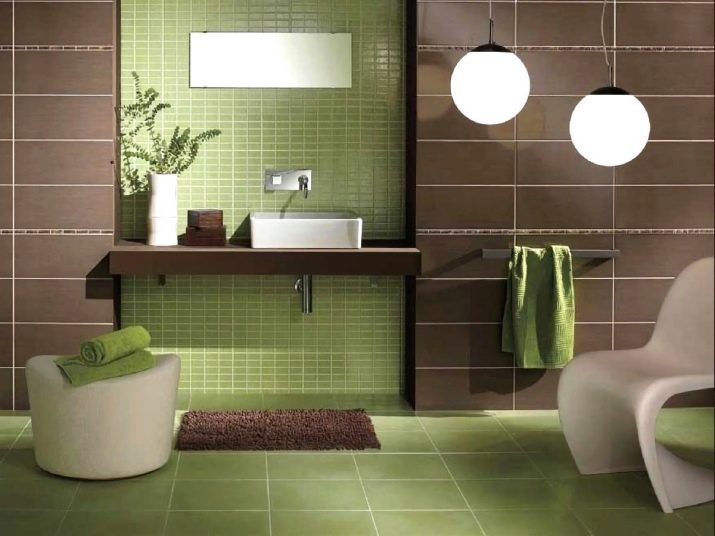
- Red will be a bright and unexpected accent for a brown bathroom.
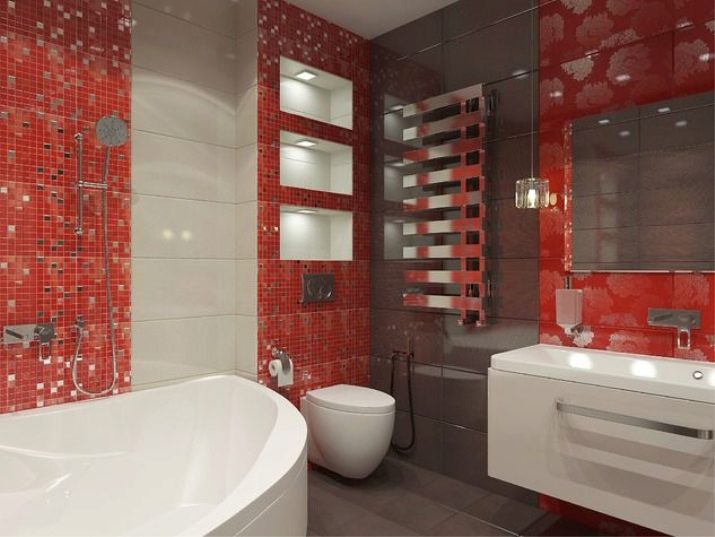
- The Provence style bathroom looks unusual. Wood imitation tiles make the interior cozy, and the delicate blue color combined with white floral tiles will become a bright accent.
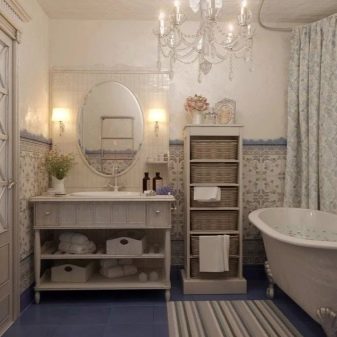
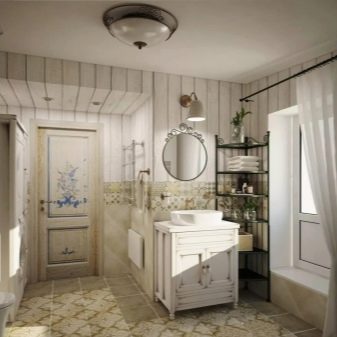
How to choose a tile for a bathroom, see the video below.








